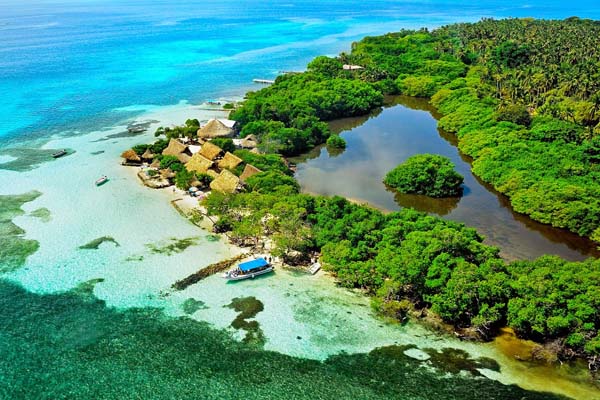Updated on 04/18/2024
Dear reader,
I would also like to recommend our Colombia travel guide, which provides a perfect overview of the tourist attractions in Colombia. Enjoy reading it!
Content
Why should you explore Colombia’s islands?
Before, you should know that Colombia, the northernmost country in South America, with a total area of more than 1 million square kilometers and a population of 48 million, has a lot to discover.

Thanks to the signing of a peace treaty between the government and one of the largest guerrilla groups – FARC, the country is beginning to leave behind its bad reputation. In 2023, nearly 6 million tourists visited Colombia, and the numbers are expected to increase.
Now, I’ll give you reasons why you should explore the islands that Colombia has:
- Impressive Nature: Colombia is a natural wonderland. Biodiversity and landscapes that will leave you speechless. And here’s a cool fact: Colombia is the only country in South America with coasts on two oceans, the Pacific and the Atlantic through the Caribbean.
- Island Destination: The country has 74 islands, from oceanic to river and lake, passing through cays and islets. Most are in the Caribbean, but there are a couple in the Pacific that are virgin, still unexplored.
- If you seek exclusivity, there are private islands you can rent, especially in the Rosario Islands, Barú, and the San Bernardo Archipelago. The best part is, they’re super accessible from cities like Cartagena, the jewel of the Colombian Caribbean, just a 10-minute boat ride away.
- For the Adventurous: If you like excursions to remote places, get ready for a trip to Malpelo Island, where the journey takes about 36 hours. But, believe me, the natural paradise you’ll find there is worth every minute.
If you want to know more about Colombia’s paradisiacal islands, keep reading!
Colombian Caribbean Islands
The Colombian Caribbean region is located in the north of the country and extends over 132,288 km², which corresponds to 1/10 of the total territory. It is home to more than 10 million people and includes tourist spots such as Cartagena, Santa Marta, San Andrés, Barranquilla, and La Guajira.
Most Colombian islands belong to this territory and attract more tourists than those on the Pacific coast. They are characterized by their warm climate, beautiful white sandy beaches with crystal clear waters, friendly people – as well as annoying vendors – and diverse wildlife!
San Andrés, Providencia, and Santa Catalina Archipelago
The archipelago of San Andrés, Providencia, and Santa Catalina is the smallest of the 32 departments in the country, yet it’s one of Colombia’s most popular destinations!
- Unique Location: It’s in the Caribbean, but curiously, closer to Nicaragua than Colombia. Although it’s 124 miles from Nicaragua and 497 miles from Colombia, it’s actually the number one vacation spot for Colombians.
- Star Islands: The vibe here is in San Andrés, Providencia, and Santa Catalina. Although only about 80,000 people live there, it’s the most densely populated place in Colombia.
- A Melting Pot of Cultures: You’ll find diversity in everything: in people (mestizos, raizales, whites, blacks), customs, and languages (Spanish, San Andrés Creole, English). And that gives it a unique cultural mix.
- Economic Engine: What drives these islands is tourism and commerce, thanks to their status as a duty-free port with a strategic location for trade. Imagine the shopping and the paradisiacal beaches!
It’s an interesting cultural hub with many tourist attractions and natural beauty that you shouldn’t miss when traveling to Colombia!
 San Andrés Island
San Andrés Island
San Andrés Island is about 124 miles from the coast of Nicaragua and is the largest island in the archipelago, with a total area of 27 km².
As the capital of the archipelago, it welcomes most tourists looking for perfect sunsets, white sandy beaches, and 27 °C palm trees for a tropical vacation. San Andrés has become a mass tourism destination. In 2023, almost a million people visited the island, after two consecutive years of receiving more than 1 million tourists.
Mass tourism is important for the economic growth of the region and depends 90% on it, as tourist activities generate jobs and income to invest in infrastructure and quality of life for the locals.
But wait, there’s more. In San Andrés, you’ll generally encounter:
- Lots of tourists.
- Vendors appearing out of nowhere.
- More trash and waste.
- Hotels or restaurants that are either mediocre or charge you an arm and a leg.
So, here are some quick tips for you to enjoy without causing trouble:
- Support the locals: Buy and eat at small businesses. That way, your money really helps the community.
- Be a responsible tourist: Take your trash with you until you find a proper place to dispose of it. And try to use less plastic. Also, be careful with the coral reefs.
- Do your research well: Before you go, look for accommodation and food options that are fair for what you’re really looking for, unless you think it has what you need and is of quality. Surely there are hidden gems!
How to get there? Transportation
You can get to San Andrés on a 2-hour flight from Bogotá and other major cities. LATAM, Viva Air, Avianca, among other companies, offer direct round-trip flights from USD $110 approx. Flights from Cartagena don’t save you much money, but they take around 40 minutes less.
- Tourists must pay a tourist card in cash at the departure lounge. It costs approximately COP$115,000 and is a required tax to ensure the island’s sustainability and invest in tourism development.
On the island, you can rent a motorcycle, a golf cart, or a mule, otherwise you can take the tourist bus, local buses for COP $ 2000, or a taxi. Walking is always an option.
Accommodation
There are several boutique hotels and resorts, as well as local inns. Decameron’s Maryland Resort is the largest all-inclusive resort in town. Find more lodging options in our blog of the best hotels in San Andres.
Activities
Here are some things to do and places to visit in San Andrés:
- Spratt Bright Beach, in the commercial area of San Andres, is surrounded by a pier of more than 1.24 miles with restaurants, hotels, bars and stores. You can enjoy water sports such as kite surfing, diving and jet skiing.
- Sound Bay, a more remote beach just off the native housing area with a stronger current and more rocks.
- Cocoplum Bay, protected by a coral reef, has calm seas and shallow, crystal clear waters that allow you to walk to Rocky Cay, a place 200 meters offshore full of underwater life.
- The Aquarium, Haynes Cay and Rose Cay offer visitors crystal clear waters recognized as a natural aquarium where you can snorkel and find typical restaurants as well as Caribbean wildlife. For example, there is a manta ray tour, but it’s best to let them enjoy their freedom.
- The Botanical Garden, a space of 8 hectares in the center of the island that purifies the air. Here you can observe the vegetation that has existed since the age of the dinosaurs and other native plants.
- Westview Park, an ecological park on the west side of the island where mangoes, pineapples, plums, tamarinds and the unique breadfruit tree, used to make desserts that you can buy, grow. You can also visit the Mermaid Cave, Morgan’s Waterfall and Piscinita, where you can snorkel and jump from the rocks.
- Morgan’s Cave, legend has it that the famous pirate Henry Morgan used to hide his stolen treasures on this island, especially in this cave. Today it is a theme park with exhibitions and dance shows.
- The Island House Museum and the First Baptist Church. The first is an 1800’s house where you can learn about local history and the second stands out for being the first Baptist church in all of Latin America and has a bell tower with a view of the entire island.
- Johnny Cay, a small island 15 minutes away by boat that is famous for its white sand beaches and large palm trees. Reggae music brings this place to life and serves as the soundtrack for fun evenings of fried fish and Cocoloco.
And very importantly, check out our San Andres travel guide for more adventures.
 Providence and Santa Catalina Islands
Providence and Santa Catalina Islands
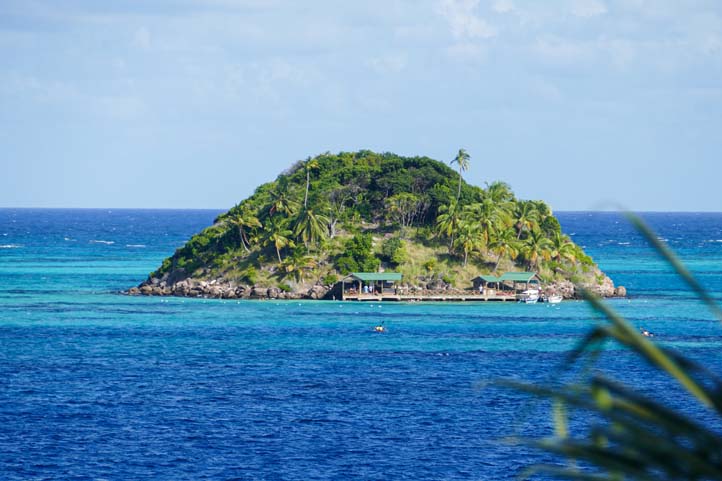
To the northeast of San Andrés, this small island is easily recognizable by its three tallest peaks. Known as “the hidden treasure of the western Caribbean,” this place amazes tourists with its beauty and marine richness.
How to get there?
You can take a 40-45 minute flight from San Andrés or a 3 and a half hour catamaran ride to reach Providencia.
Accommodation
You can find more information on where to stay in Providencia in our Travel Guide to Providencia Island in Colombia.
Attractions
- Activities include visiting beautiful beaches, diving, or hiking to enjoy landscapes like the sea of 7 colors.
- It takes a couple of hours to tour the island in a golf cart. You can stop at deserted beaches or interact with locals, who have the English tradition of drinking tea.
- The Lovers’ Bridge is a 150-meter floating structure that connects both islands, and rumor has it that couples who cross the bridge together will have eternal love. It’s made of brightly painted wood and allows boats to pass through a narrow tunnel.
- Also, indulge in typical food such as seafood, fish, banana cake, and crab empanadas while listening reggae, soca, and calypso.
Islands near Cartagena
Cartagena has a lot to offer tourists, but apart from the mainland, there are other fabulous places to discover! Here are some of the best islands near Cartagena.
 Tierra Bomba
Tierra Bomba
Tierra Bomba is an island of almost 20 km² south of Cartagena divided into 5 areas: Punta Arena, Caño de Loro, Bocachica, Tierra Bomba, and Isla Nueva. Despite being very close to the colonial city, this island remains untouched and is home to 9000 people.
How to get there?
Easily accessed by boat from El Laguito Pier, Castillogrande, or Los Pegasos in Cartagena. The journey only takes 10 minutes.
Accommodation
The island has some hotels, among which Fenix Beach Cartagena and Blue Apple Beach House stand out.
Attractions
- Its 43 kilometers of coastline have incredible beaches like Punta Arena, Playa Linda, Playa Palmarito, Playa Chiringuito, and Playa Marina, where you can enjoy the view of Cartagena’s skyline.
- If you’ve had enough sand and sea, Tierra Bomba’s highlight is the San Fernardo de Bocahica fortress, built between 1714 and 1725 to protect the city from pirates.
 Barú
Barú
Barú is one of Cartagena’s most visited places, located in the south of the city. This former peninsula was separated from the mainland by the Canal del Dique, an artificial canal built to connect the Magdalena River with Cartagena Bay, forming an artificial island.
Is one of those places where you feel like you are in heaven and since a bridge was built, tourism has skyrocketed. Although today this activity caters to the 20,000 inhabitants, unfortunately tourists exceed the capacity of the island and damage the local nature.
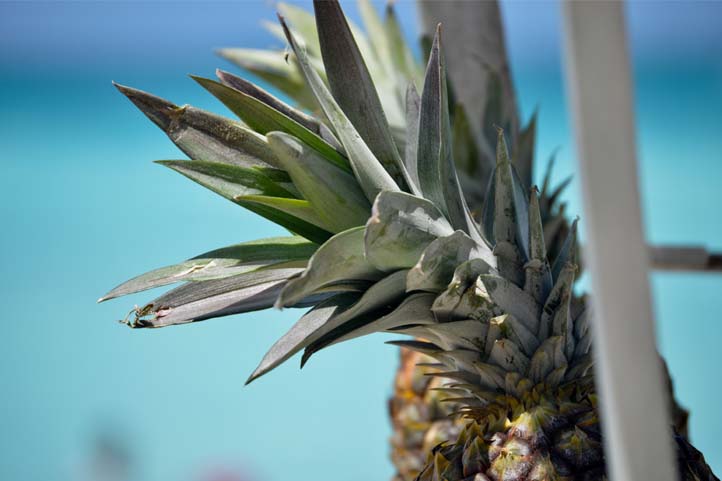
How to get there?
Located 45 minutes from Cartagena by boat. This was the only way to get there until 2014 when the Barú Bridge was inaugurated, making it easier to travel there.
Accommodation
There is a wide range of beach hotels and resorts including Hotel Las Islas, Decameron, and Hotel Isla del Encanto.
Also check out the blog I wrote with the best beach hotels in Colombia, to learn about my experience at Hotel las Islas.
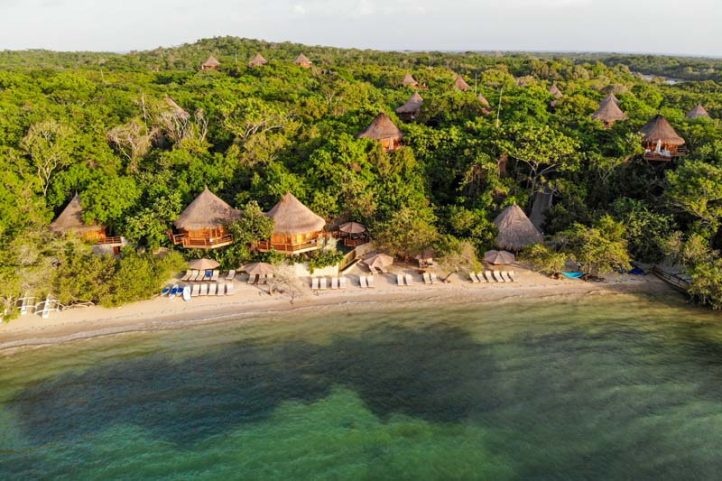
Attractions
- Baru has beautiful white sand beaches with turquoise waters, canals surrounded by mangroves and even some multicolored coral reefs.
- Playa Cholón, Punta Iguana, Playa Puntilla, Playa de los Muertos, Playa Bobo and Punta Barú are the most popular beaches and are private or belong to tourist companies, Playa Blanca is the only public beach.
- Playa Blanca: stands out for its white sand beaches and crystal clear waters, but lacks tourist control. Visitors are almost always confronted with street vendors and garbage. In addition, you will notice that the quality of hotels and services is generally low.
- Playa Puntilla: This is a better classified beach as it belongs to the Decameron Baru hotel chain. Guests have access to a private club and can practice water sports.
- National Aviary: As Colombia is the country with the greatest diversity of birds in the world, here you can visit the national aviary and have a 2-hour tour where you will find 21 exhibits and 3 ecosystems where 170 species of birds live. This is almost a must for birdwatchers!
 Rosario Islands
Rosario Islands
This archipelago, also known as the Corales del Rosario, is formed by 27 islands with a total area of 20 hectares. Some of them are too small and uninhabited.
Highlights
One of the standout features here is the Corales del Rosario National Natural Park, established to safeguard one of the country’s most significant coral reefs along the Caribbean coast.
How to get there
From Los Pegasos Pier in the historic center of Cartagena, you can board a boat that will take you to these islands in approximately 45 minutes.
Accommodation
The region offers various options, ranging from medium-sized hotels to several eco-friendly lodgings.
Attractions
- Isla Grande, the largest island in the archipelago, attracts the most tourists. The Enchanted Lagoon offers a stunning view with bioluminescent plankton making the water shimmer. However, Isla Grande is on high alert due to mass tourism and illegal trade.
- Marine Tourism: Crystal-clear waters here are perfect for activities like diving, snorkeling, and other water sports.
- Natural Aquarium on San Martín de Pajarales Island: A saltwater aquarium where you can see colorful fish, various shark species, turtles, and other marine life.
- Corales del Rosario and San Bernardo National Natural Marine Park: Encompassing ecosystems like coral reefs, wetlands, and mangroves, it’s home to countless microscopic animals, fish, crustaceans, mollusks, anemones, sea urchins, starfish, and various seabirds.
- Fuerte Island, though less known, is a fantastic spot for nature-based tourism activities. You can swim, surf, and hike through tropical forests or hidden caves.
- Other Rosario islands are Isla Marina Island, Roberto Island, Tesoro Island, Pirata Island and Fiesta Island.
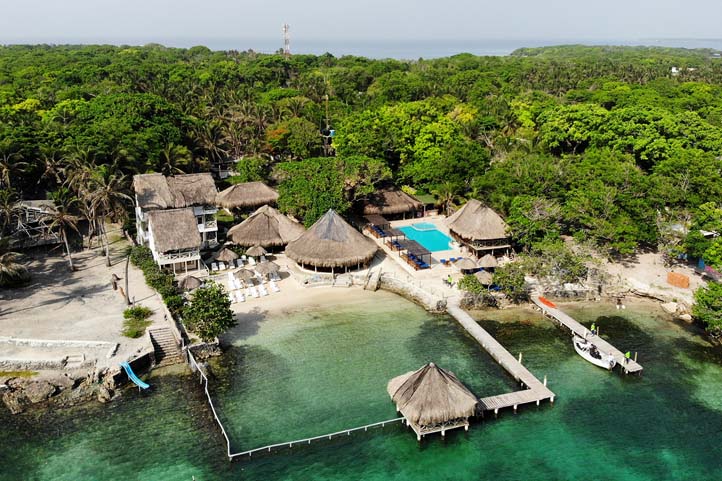
San Bernardo Archipelago
Located off the Morrosquillo Gulf, southwest of Cartagena, this archipelago consists of 10 islands with turquoise waters spread over 213 km² and inhabited by 1300 people reliant on fishing. Part of it belongs to the Corales del Rosario and San Bernardo National Natural Park.
How to get there
Two ways from Cartagena: a 2-hour speedboat ride or drive to Tolú (3 hours) then take a 20-minute boat ride.
Accommodation
Some hotels are available, including the luxurious Punta Faro resort and a floating hostel called Casa en el Agua, literally over the water.
Attractions
- Santa Cruz del Islote: Known for being the world’s most densely populated artificial island, it fascinates tourists with its 1-hectare surface and about 500 mostly young inhabitants living in 90 houses.
- Electricity is supplied by a fuel plant located on the island and solar panels. It has 1 hostel with very good ratings.
- Múcura Island: Larger with beautiful beaches, mangroves, and corals. Punta Faro Hotel offers activities like biking, water sports, and hiking trails.
- Tintipán Island: Swim with bioluminescent plankton, dive, snorkel, or dolphin watch.
- Other islands include Maravilla, Mangle, Panda, Palma, Cabruna, Ceycén, and Boquerón.
Colombian Islands in the Pacific Ocean
The Colombian Pacific coast boasts rich ecological, hydrographic, mineral, and forest wealth, making it one of the planet’s most biodiverse and rainy regions. Despite this, it remains underestimated in tourism, especially by locals, due to its low population density and climatic conditions.
Pacific region stands out for its great biodiversity. That’s why there are more than 5 natural national parks preserving the local flora and fauna. In fact, the only 2 islands in the Colombian Pacific Ocean are important natural reserves.
Keep reading to discover what these islands have to offer!
 Malpelo Island
Malpelo Island
Malpelo Island is commonly known as “the living rock,” situated as the westernmost point of Colombia, 310 miles off the Pacific coast.
The island essentially consists of a single square kilometer rock at 360 meters above sea level, which may not seem very appealing to tourists. However, it was declared a UNESCO World Heritage Site in 2006 due to the wide variety of wildlife it hosts. In reality, it’s a Colombian Flora and Fauna Sanctuary.
It’s surrounded by 11 small islets:
- 4 located at the northern tip of the island known as “Los Mosqueteros”: Athos, Porthos, Aramis, and D’Artagnan.
- 2 are to the east: Vagamares and La Torta.
- 5 are at the southern end: La Gringa, Escuba, and The Three Kings (David, Saul, and Solomon).
The only building on the island is a military detachment built in 1986 to protect the area from illegal fishing and other harmful environmental practices.
How to Get There?
The journey is a 36-hour boat trip from the port of Buenaventura, and there are only 3 authorized tour operators. It may be long, but it’s worth it.
Notes
To visit Malpelo Island, there are some requirements:
- You must be over 18 years old or have permission from your parents.
- You must have a diving certificate and a minimum of 35 previously registered dives.
- For diving, there must be one guide for every 6 people, and everyone must have the minimum safety equipment.
- It is recommended, but not mandatory, to be vaccinated against yellow fever and tetanus.
Attractions
- Most visitors are scientists or diving professionals. They come to observe the wonderful ecosystems such as rocky shores and coral reefs along with native wildlife.
- Biodiversity Hotspot: An interesting fact is that there are more than 300 species of fish, 60 species of birds (e.g., Nazca boobies), and a wide variety of marine fauna (crustaceans, mollusks, corals, and starfish).
- It’s in the top 10 best places to observe sharks, as the area is teeming with different species such as hammerhead sharks, smooth hound sharks (or Malpelo monsters), and whale sharks.
- Come and meet the endemic species of Malpelo, such as the terrestrial red crab, the Malpelo lizard, the spotted lizard, and the gecko!
 Gorgona Island
Gorgona Island
Gorgona Island is a natural paradise easily visible from the sea on the Pacific coast of Colombia. A majestic tropical jungle extends from the small peaks to the shore alongside an intense blue sea.
Gorgona and Gorgonilla are the islands that make up this national park, in fact, it’s called so because of the Greek female creatures resembling snakes that abound in the area.
Fun Fact: This island was a maximum-security prison for 25 years! Then, in 1984, it became a protected natural area that is now on the list of must-visit places for many researchers and nature lovers.
How to Get There?
- By plane: A flight with a stopover lasts about 4 hours from Bogotá to Guapi. TAC and SATENA airlines offer a daily round trip from Cali and Tumaco, respectively.
- By boat: You can book a boat service from Guapi that will take you to the island in an hour and a half or two hours. Alternatively, from the port of Buenaventura, there are fast boat services offering round trips for groups of more than 10 people.
Accommodation
Colombian National Natural Parks offers a small hotel and a restaurant.
Notes
- It is recommended, but not mandatory, to be vaccinated against yellow fever and tetanus.
Attractions
- Challenge yourself on one of the 4 hiking trails. These allow you to see the ruins of the old prison, the ocean, some bridges, and wooden stairs. Additionally, you’ll be able to see the great variety of species that inhabit the jungle and the water and clean energy plants that supply the island.
- Bird lovers can observe species such as frigatebirds, pelicans, and boobies (Sula genus).
- In addition to birds, Gorgona has rich marine life: 381 species of fish, 11 species of whales and dolphins, and 4 species of sea lions.
- Moreover, one of the most popular attractions is the migration of humpback whales to the island. Here you can see them every year from July to October.
- Gorgona is a paradise for divers due to its biodiversity; there are many sites on the island for this activity.
Other Islands
 Corota Island
Corota Island
In the Laguna de la Cocha, a large lake in the department of Nariño, lies this small island of 12 hectares. Despite its size, it’s a Flora and Fauna Sanctuary of the Colombian National Parks System. It’s actually the smallest protected area in the country’s national parks system.
It’s a unique island, as it has a cold rainforest ecosystem, instead of the typical tropical dry forest. It’s at 2,830 meters above sea level and has an average temperature of 11°C.
How to Get There?
If you travel to southern Colombia, you can take a 1-hour trip from the capital of Nariño, Pasto.
Attractions
- Most tourists come to observe the rich wildlife living in this area. You can find 1,500 plant species along with various ducks, reptiles, amphibians, and fish.
- It also has historical and spiritual value as the Quillasinga indigenous community inhabited the region 500 years ago and considered the island a sacred place for their culture.
 Micos Island
Micos Island
Micos Island is a river island, actually called Arara Island, located on the Amazon border with Peru. It’s 20 kilometers from Leticia, the capital of the Amazonas department, and is famous for being the kingdom of monkeys.
The common squirrel monkey is the largest in the area and attracts many tourists. They are friendly, and there are people who feed them, but it’s better not to. Enjoy watching them from a distance. That way, we’re all better off!
You can learn more about the Amazon in our Amazon travel guide.
How to Get There?
You can take a boat from Leticia that sails the river to the island. There are several tour operators offering different packages.
Accommodation
There was a hotel in the past, but now it serves as a refuge for some indigenous peoples who sell crafts to tourists.
Attractions
- Explore the island and watch hundreds of monkeys move freely around you; they may even jump on you to ask for food.
- Birdwatchers can also enjoy different bird species, and caimans appear from everywhere.
- You can also go canoeing in the lakes around the island or climb trees. There are trees over 40 meters high from where you can see the vastness of the Amazon jungle!
Colombia Travel Tips
- Colombia Travel Medical Advice & Vaccination Details
- 29 Travel Tips You Need To Know Before Coming To Colombia
- 99 Facts & Information About Colombia You Should Know
- Colombia Weather Guide for Travelers
More Destinations in Colombia
- 99 Must-See Destinations that Will Make You Fall in Love with Colombia
- Colombia’s Top 23 Largest and most Important Cities – Key Data and Insights
- 7 Wonders of Colombia Complete Guide
- Colombia’s Top 117 Museums: A Cultural Traveler’s Comprehensive Journey
- 21 Spectacular Churches in Colombia
- What Are The Best Luxury Destinations In Colombia?
- Sample Luxury Travel Itinerary in Colombia
- Instagram Colombia – The 17 Most Beautiful Places for Photos

